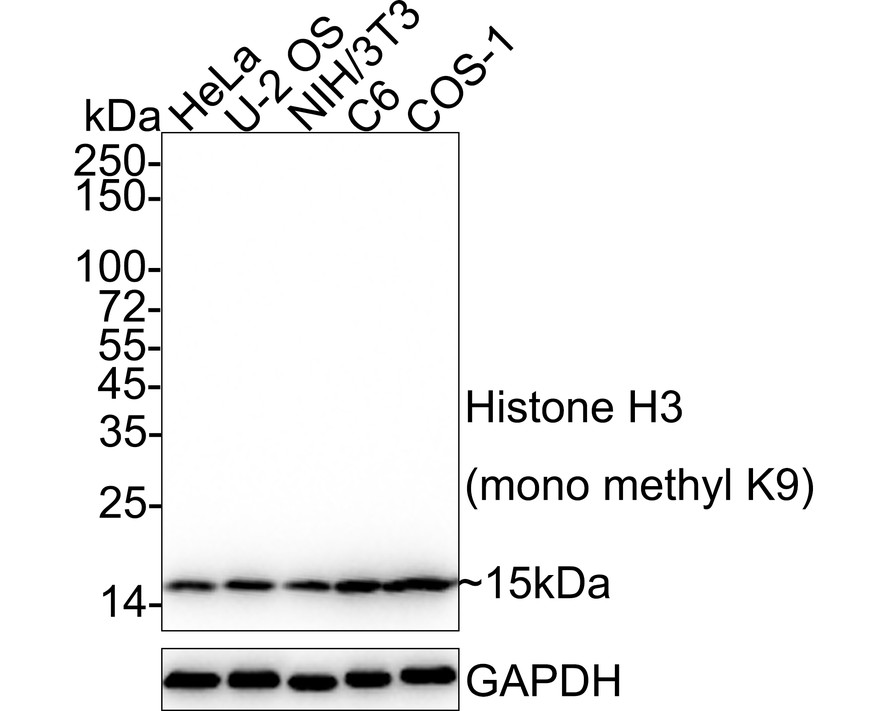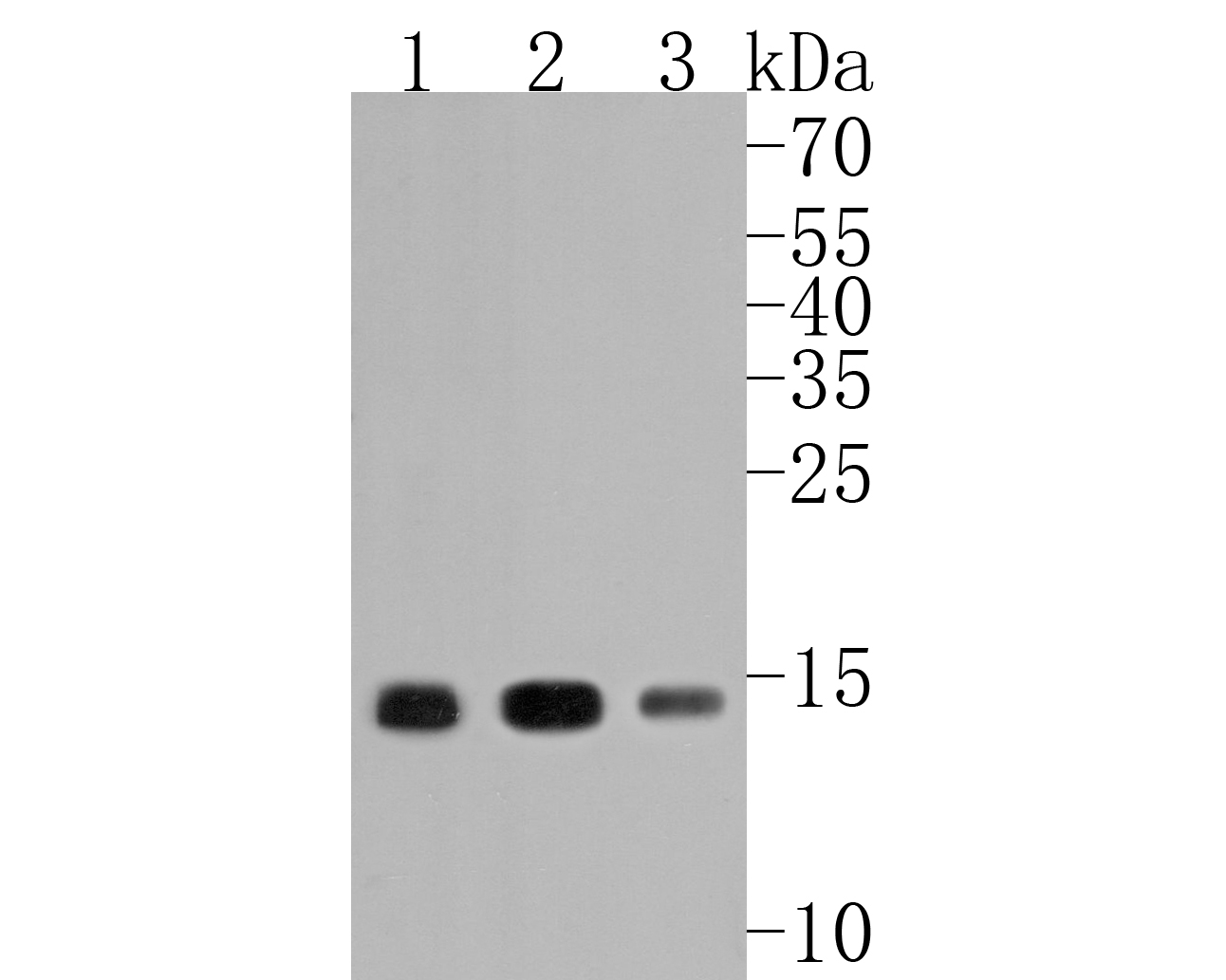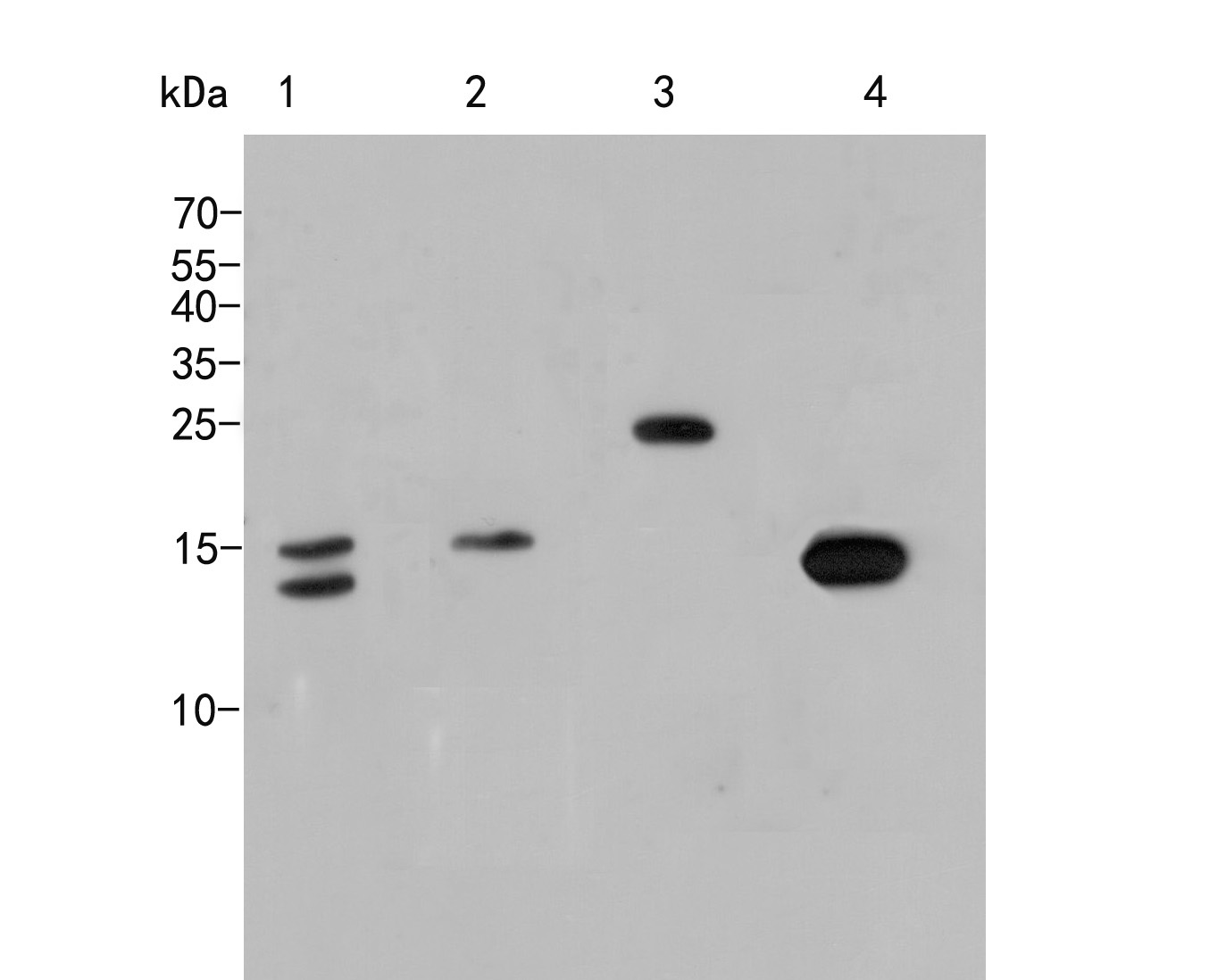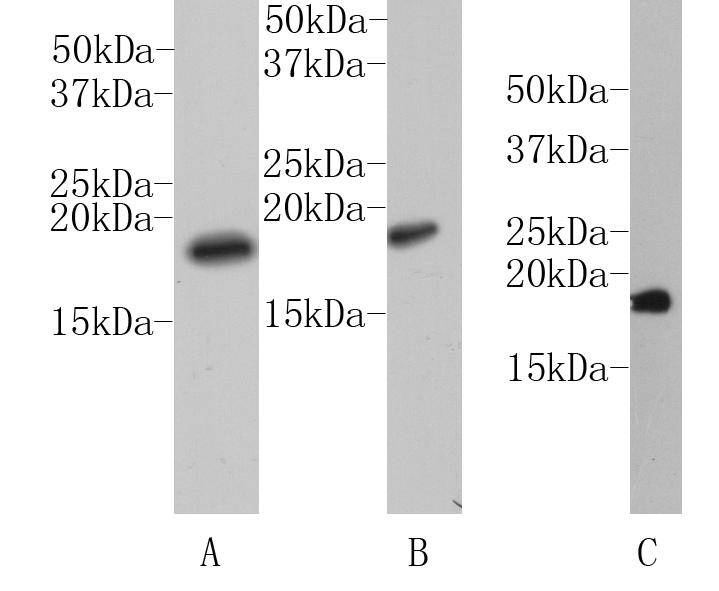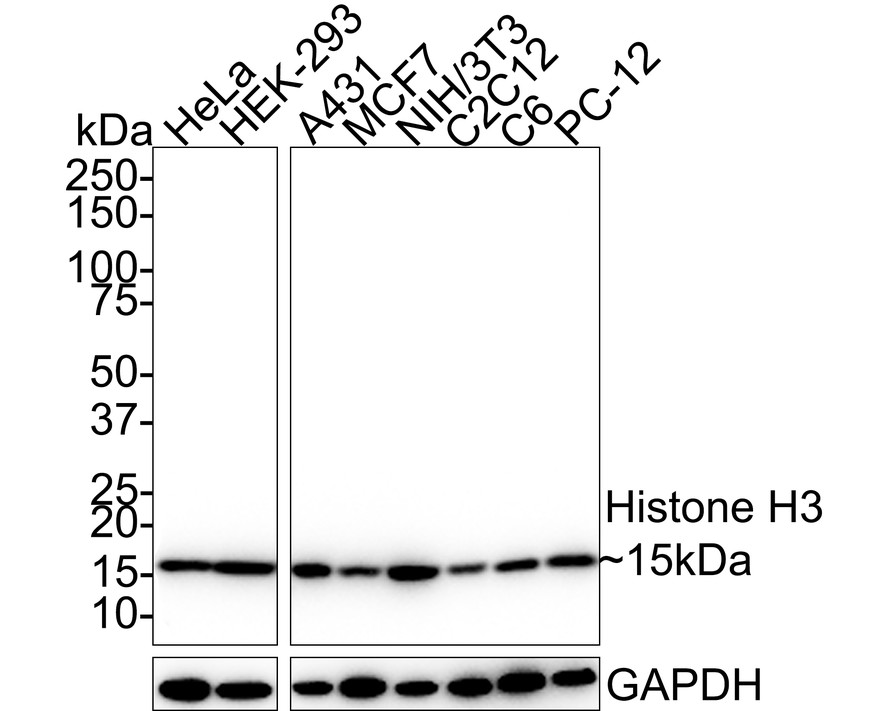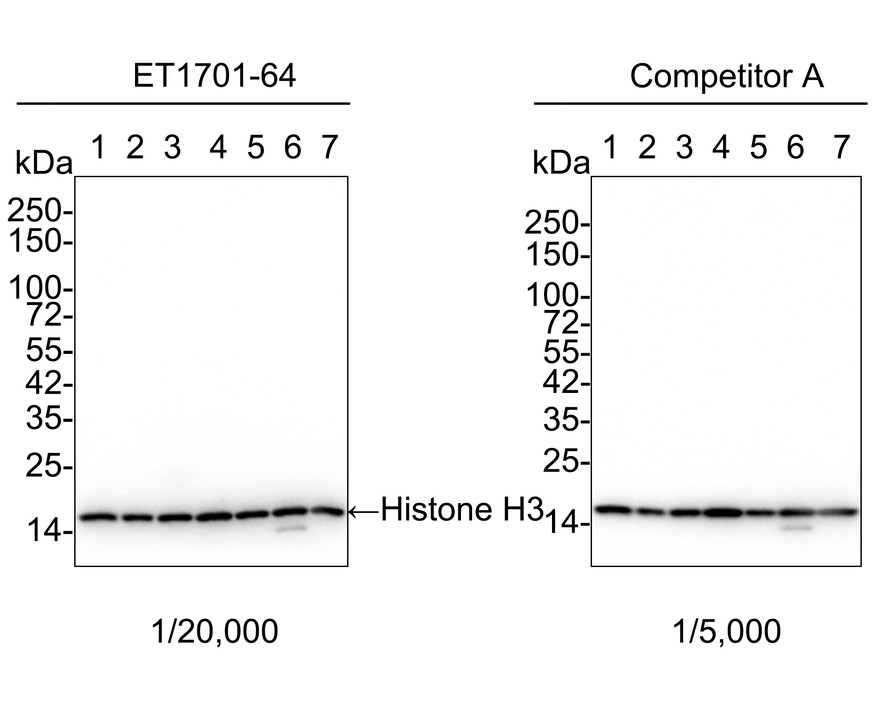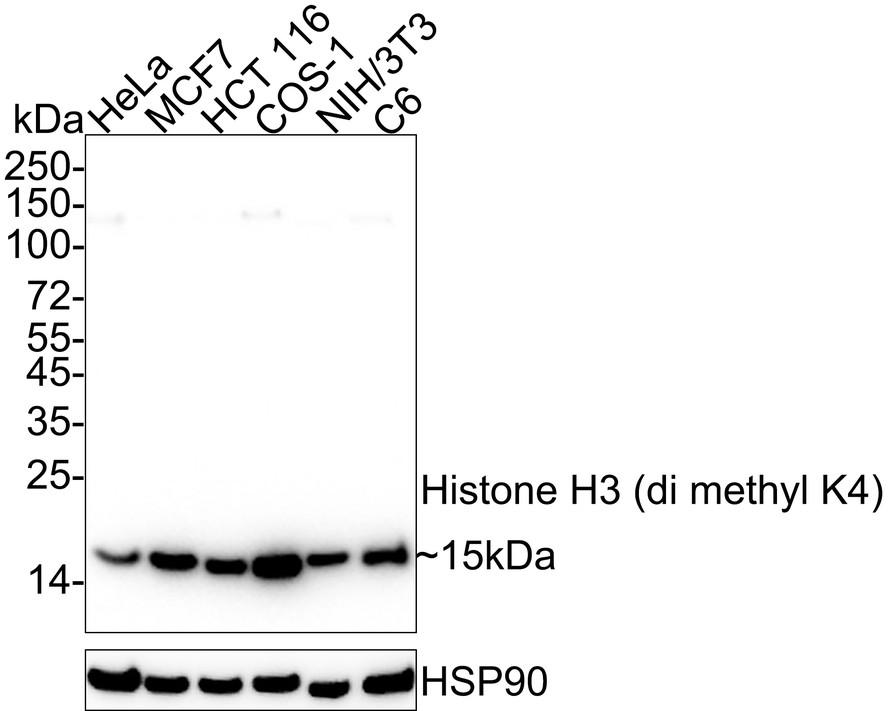概述
产品名称
Histone H3 (acetyl K27) Mouse Monoclonal Antibody [A6D7]
抗体类型
Mouse Monoclonal Antibody
免疫原
Synthetic peptide within human Histone H3 aa 20-40 (acetyl K27).
种属反应性
Human, Mouse, Rat
验证应用
WB, IF-Cell, IHC-P, FC, ChIP
分子量
Predicted band size: 15 kDa
阳性对照
293 cell lysate, MCF-7 cell lysate, NIH/3T3 cell lysate, PC-12 cell lysate, HeLa cell lysates, HeLa treated with Trichostatin A whole cell lysates, HUVEC, NIH/3T3, human tonsil tissue, HeLa.
偶联
unconjugated
克隆号
A6D7
RRID
产品特性
形态
Liquid
浓度
2ug/ul
存放说明
Store at +4℃ after thawing. Aliquot store at -20℃. Avoid repeated freeze / thaw cycles.
存储缓冲液
PBS (pH7.4), 0.05% BSA, 40% Glycerol. Preservative: 0.05% Sodium Azide.
亚型
IgG1
纯化方式
Protein G affinity purified.
应用稀释度
-
WB
-
1:500-1:2,000
-
IF-Cell
-
1:100
-
IHC-P
-
1:600
-
FC
-
1:1,000
-
ChIP
-
Use 0.5~2 μg for 25 μg of chromatin.
发表文章中的应用
发表文章中的种属
| human | See 1 publications below |
靶点
功能
Eukaryotic histones are basic and water soluble nuclear proteins that form hetero-octameric nucleosome particles by wrapping 146 base pairs of DNA in a left-handed super-helical turn sequentially to form chromosomal fibers. Two molecules of each of the four core histones (H2A, H2B, H3 and H4) form the octamer, which is comprised of two H2A-H2B dimers and two H3-H4 dimers, forming two nearly symmetrical halves by tertiary structure. Histones are subject to posttranslational modification by enzymes primarily on their N-terminal tails, but also in their globular domains. Human and mouse Histone H4 are subject to methylation at Lys 20, a modification that may be necessary for select DNA transactions or chromatin state transitions.
背景文献
1. Ray-Gallet D. et. al. The Histone H3 Family and Its Deposition Pathways. Adv Exp Med Biol. 2021
2. Francis NJ. et. al. Inheritance of Histone (H3/H4): A Binary Choice? Trends Biochem Sci. 2021 Jan
亚细胞定位
Nucleus, Chromosome.
UNIPROT #
别名
HIST1 cluster, H3J antibody
Histone gene cluster 1, H3 histone family, member E antibody
Histone gene cluster 1, H3G antibody
H3 histone family, member J antibody
HIST1 cluster, H3E antibody
HIST1 cluster, H3I antibody
Histone gene cluster 1, H3C antibody
FLJ92264 antibody
H3 histone family, member A antibody
H3 histone family, member B antibody
展开HIST1 cluster, H3J antibody
Histone gene cluster 1, H3 histone family, member E antibody
Histone gene cluster 1, H3G antibody
H3 histone family, member J antibody
HIST1 cluster, H3E antibody
HIST1 cluster, H3I antibody
Histone gene cluster 1, H3C antibody
FLJ92264 antibody
H3 histone family, member A antibody
H3 histone family, member B antibody
H3 histone family, member C antibody
H3 histone family, member D antibody
H3 histone family, member F antibody
H3 histone family, member H antibody
H3 histone family, member I antibody
H3 histone family, member K antibody
H3 histone family, member L antibody
H3 histone family, member T antibody
H3 histone, family 3A antibody
H3.1 antibody
H3.3A antibody
H3/a antibody
H3/b antibody
H3/c antibody
H3/d antibody
h3/f antibody
H3/h antibody
H3/i antibody
H3/j antibody
H3/k antibody
H3/l antibody
H3/t antibody
H31_HUMAN antibody
H3F1K antibody
H3F3 antibody
H3F3A antibody
H3FA antibody
H3FB antibody
H3FC antibody
H3FD antibody
H3FF antibody
H3FH antibody
H3FI antibody
H3FJ antibody
H3FK antibody
H3FL antibody
HIST1 cluster, H3A antibody
HIST1 cluster, H3B antibody
HIST1 cluster, H3C antibody
HIST1 cluster, H3D antibody
HIST1 cluster, H3F antibody
HIST1 cluster, H3G antibody
HIST1 cluster, H3H antibody
HIST1H3A antibody
HIST1H3B antibody
HIST1H3C antibody
HIST1H3D antibody
HIST1H3E antibody
HIST1H3F antibody
HIST1H3G antibody
HIST1H3H antibody
HIST1H3I antibody
HIST1H3J antibody
HIST3H3 antibody
Histone 1, H3a antibody
Histone 1, H3b antibody
Histone 1, H3c antibody
Histone 1, H3d antibody
Histone 1, H3e antibody
Histone 1, H3f antibody
Histone 1, H3g antibody
Histone 1, H3h antibody
Histone 1, H3i antibody
Histone 1, H3j antibody
histone 3, H3 antibody
histone cluster 1 H3 family member a antibody
histone cluster 1 H3 family member b antibody
histone cluster 1 H3 family member c antibody
histone cluster 1 H3 family member d antibody
histone cluster 1 H3 family member e antibody
histone cluster 1 H3 family member f antibody
histone cluster 1 H3 family member g antibody
histone cluster 1 H3 family member h antibody
histone cluster 1 H3 family member i antibody
histone cluster 1 H3 family member j antibody
Histone cluster 1, H3a antibody
Histone cluster 1, H3b antibody
Histone cluster 1, H3c antibody
Histone cluster 1, H3d antibody
Histone cluster 1, H3e antibody
Histone cluster 1, H3f antibody
Histone cluster 1, H3g antibody
Histone cluster 1, H3i antibody
Histone cluster 1, H3j antibody
Histone gene cluster 1, H3 histone family, member A antibody
Histone gene cluster 1, H3 histone family, member B antibody
Histone gene cluster 1, H3 histone family, member C antibody
Histone gene cluster 1, H3 histone family, member D antibody
Histone gene cluster 1, H3 histone family, member F antibody
Histone gene cluster 1, H3 histone family, member G antibody
Histone gene cluster 1, H3 histone family, member H antibody
Histone gene cluster 1, H3 histone family, member I antibody
Histone gene cluster 1, H3 histone family, member J antibody
Histone gene cluster 1, H3A antibody
Histone gene cluster 1, H3B antibody
Histone gene cluster 1, H3D antibody
Histone gene cluster 1, H3E antibody
Histone gene cluster 1, H3F antibody
Histone gene cluster 1, H3H antibody
Histone gene cluster 1, H3I antibody
Histone gene cluster 1, H3J antibody
Histone H 3 antibody
Histone H3.1 antibody
histone H3.1t antibody
Histone H3.2 antibody
Histone H3/a antibody
Histone H3/b antibody
Histone H3/c antibody
Histone H3/d antibody
Histone H3/f antibody
Histone H3/h antibody
Histone H3/i antibody
Histone H3/j antibody
Histone H3/k antibody
Histone H3/l antibody
Histone H3/m antibody
Histone H3/o antibody
H3K27ac antibody
折叠图片
-
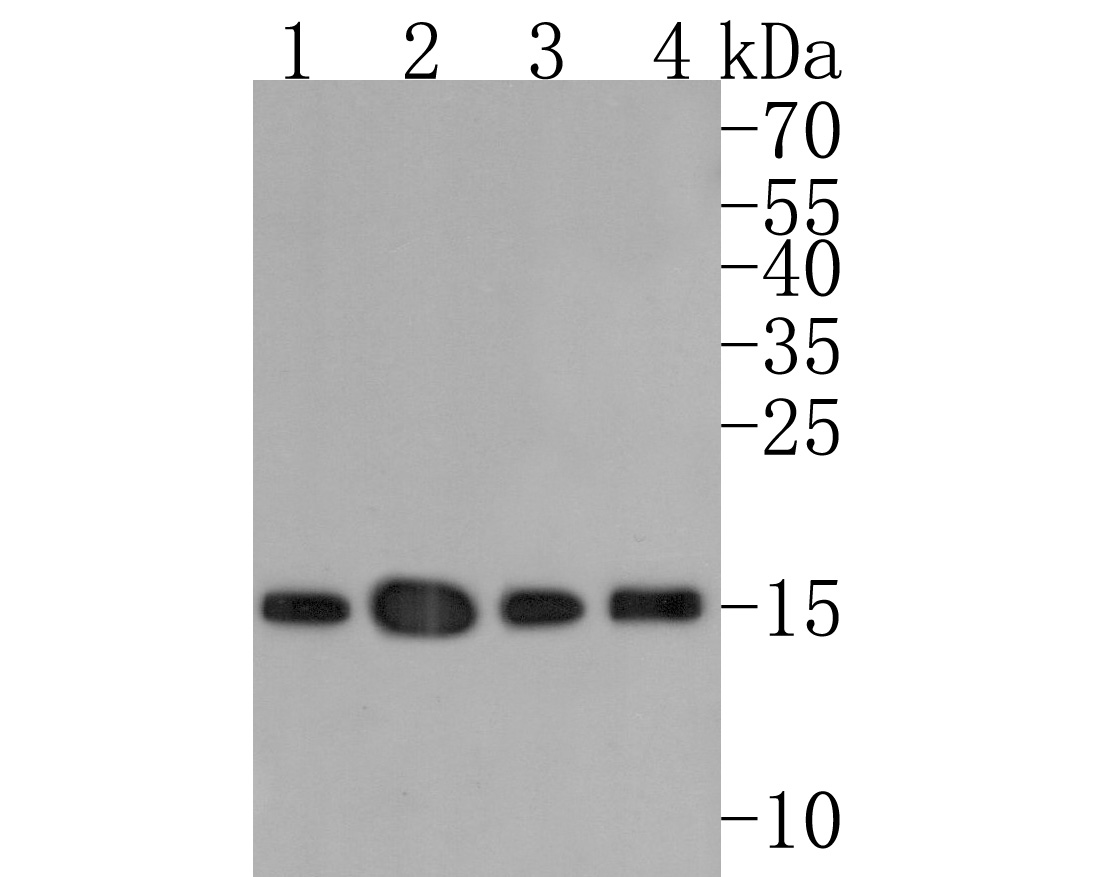
Western blot analysis of Histone H3 (acetyl K27) on different lysates. Proteins were transferred to a PVDF membrane and blocked with 5% BSA in PBS for 1 hour at room temperature. The primary antibody (HA600047, 1/500) was used in 5% BSA at room temperature for 2 hours. Goat Anti-Mouse IgG - HRP Secondary Antibody (HA1006) at 1:20,000 dilution was used for 1 hour at room temperature.
Positive control:
Lane 1: 293 cell lysate
Lane 2: MCF-7 cell lysate
Lane 3: NIH/3T3 cell lysate
Lane 4: PC-12 cell lysate -

☑ Cell treatment (CT)
Western blot analysis of Histone H3 (acetyl K27) on HeLa cell lysates. Proteins were transferred to a PVDF membrane and blocked with 5% BSA in PBS for 1 hour at room temperature. The primary antibody (HA600047, 1/500) was used in 5% BSA at room temperature for 2 hours. Goat Anti-Mouse IgG - HRP Secondary Antibody (HA1006) at 1:20,000 dilution was used for 1 hour at room temperature.
Lane 1: Untreated HeLa whole cell lysates
Lane 2: HeLa treated with Trichostatin A whole cell lysates -

Immunocytochemistry analysis of HUVEC cells labeling Histone H3 (acetyl K27) with Mouse anti-Histone H3 (acetyl K27) antibody (HA600047) at 1/100 dilution.
Cells were fixed in 4% paraformaldehyde for 15 minutes at room temperature, permeabilized with 0.1% Triton X-100 in PBS for 15 minutes at room temperature, then blocked with 1% BSA in 10% negative goat serum for 1 hour at room temperature. Cells were then incubated with Mouse anti-Histone H3 (acetyl K27) antibody (HA600047) at 1/100 dilution in 1% BSA in PBST overnight at 4 ℃. Goat Anti-Mouse IgG H&L (iFluor™ 488, HA1125) was used as the secondary antibody at 1/1,000 dilution. PBS instead of the primary antibody was used as the secondary antibody only control. Nuclear DNA was labelled in blue with DAPI.
beta Tubulin (ET1602-4, red) was stained at 1/100 dilution overnight at +4℃. Goat Anti-Rabbit IgG H&L (iFluor™ 594, HA1122) was used as the secondary antibody at 1/1,000 dilution. -

Immunocytochemistry analysis of NIH/3T3 cells labeling Histone H3 (acetyl K27) with Mouse anti-Histone H3 (acetyl K27) antibody (HA600047) at 1/1,000 dilution.
Cells were fixed in 4% paraformaldehyde for 15 minutes at room temperature, permeabilized with 0.1% Triton X-100 in PBS for 15 minutes at room temperature, then blocked with 1% BSA in 10% negative goat serum for 1 hour at room temperature. Cells were then incubated with Mouse anti-Histone H3 (acetyl K27) antibody (HA600047) at 1/1,000 dilution in 1% BSA in PBST overnight at 4 ℃. Goat Anti-Mouse IgG H&L (iFluor™ 488, HA1125) was used as the secondary antibody at 1/1,000 dilution. PBS instead of the primary antibody was used as the secondary antibody only control. Nuclear DNA was labelled in blue with DAPI.
beta Tubulin (ET1602-4, red) was stained at 1/100 dilution overnight at +4℃. Goat Anti-Rabbit IgG H&L (iFluor™ 594, HA1122) was used as the secondary antibody at 1/1,000 dilution. -

Immunohistochemical analysis of paraffin-embedded human tonsil tissue using anti-Histone H3 (acetyl K27) antibody. The section was pre-treated using heat mediated antigen retrieval with sodium citrate buffer (pH 6.0) for 20 minutes. The tissues were blocked in 1% BSA for 30 minutes at room temperature, washed with ddH2O and PBS, and then probed with the primary antibody (HA600047, 1/600) for 30 minutes at room temperature. The detection was performed using an HRP conjugated compact polymer system. DAB was used as the chromogen. Tissues were counterstained with hematoxylin and mounted with DPX.
-

Flow cytometric analysis of Histone H3 (acetyl K27) was done on HeLa cells. The cells were fixed, permeabilized and stained with the primary antibody (HA600047, 1ug/ml) (red) compared with Rabbit IgG, monoclonal - Isotype Control (green). After incubation of the primary antibody at +4℃ for 1 hour, the cells were stained with a Alexa Fluor®488 conjugate-Goat anti-Mouse IgG Secondary antibody at 1/1000 dilution for 30 minutes at +4℃ (dark incubation).Unlabelled sample was used as a control (cells without incubation with primary antibody; black).
-

☑ Cell treatment (CT)
Chromatin immunoprecipitations were performed with cross-linked chromatin from HeLa cells treated with 500ng/mL TSA for 4 hours and either Histone H3 (acetyl K27) (HA600047) or Normal Mouse IgG according to the ChIP protocol. The enriched DNA was quantified by real-time PCR using indicated primers. The amount of immunoprecipitated DNA in each sample is represented as signal relative to the total amount of input chromatin, which is equivalent to one.
Please note: All products are "FOR RESEARCH USE ONLY AND ARE NOT INTENDED FOR DIAGNOSTIC OR THERAPEUTIC USE"
引文
-
Nr-CWS regulates METTL3-mediated m6A modification of CDS2 mRNA in vascular endothelial cells and has prognostic significance
Author: Jingyu Zhang,et al
PMID: NO PMID 2024102505
应用: WB
反应种属: human
发表时间: 2024 Oct
-
Citation
同靶点&同通路的产品
Histone H3 (mono methyl K79) Recombinant Rabbit Monoclonal Antibody [PSH07-66]
Application: WB,IF-Cell,IHC-P,FC,ChIP
Reactivity: Human,Mouse,Rat,Monkey
Conjugate: unconjugated
Phospho-Histone H3 (S28) Recombinant Rabbit Monoclonal Antibody [JE56-06]
Application: WB,IF-Cell,IHC-P,FC,ChIP
Reactivity: Human,Rat,Mouse
Conjugate: unconjugated
Histone H3 (mono methyl K36) Recombinant Rabbit Monoclonal Antibody [SR04-20]
Application: WB,IF-Cell,IF-Tissue,ChIP
Reactivity: Human,Mouse
Conjugate: unconjugated
Histone H3 (mono methyl R2) Recombinant Rabbit Monoclonal Antibody [ST0427]
Application: WB,IF-Cell,IF-Tissue,IHC-P,ChIP
Reactivity: Human,Mouse,Rat
Conjugate: unconjugated
Histone H3 (acetyl K56) Recombinant Rabbit Monoclonal Antibody [SU30-10]
Application: WB,IF-Cell,IF-Tissue,IHC-P,ChIP,CUT&Tag-seq
Reactivity: Human,Mouse,Rat
Conjugate: unconjugated
Histone H3 (tri methyl K9) Mouse Monoclonal Antibody [1-6]
Application: WB,IF-Cell,IHC-P,IF-Tissue
Reactivity: Human,Mouse,Rat
Conjugate: unconjugated
Histone H3 Mouse Monoclonal Antibody [A11-D7]
Application: WB,IF-Cell,IHC-P,IF-Tissue
Reactivity: Human,Mouse,Rat,Zebrafish
Conjugate: unconjugated
Histone H3 (tri methyl K27) Recombinant Rabbit Monoclonal Antibody [PSH05-15]
Application: WB,IF-Cell,IHC-P,IF-Tissue,ChIP
Reactivity: Human,Mouse,Rat
Conjugate: unconjugated
Histone H3 (di methyl K4) Rabbit Polyclonal Antibody
Application: WB,IF-Cell,IHC-P,FC,Dot Blot
Reactivity: Human,Mouse,Rat
Conjugate: unconjugated
Histone H3 (mono methyl K9) Recombinant Rabbit Monoclonal Antibody [JE43-27]
Application: WB,IF-Cell,IHC-P,FC,ChIP,IF-Tissue,Dot Blot
Reactivity: Human,Mouse,Rat,Monkey
Conjugate: unconjugated
Histone H3 (mono methyl K27) Recombinant Rabbit Monoclonal Antibody [PSH05-67]
Application: WB,IF-Cell,FC,ChIP
Reactivity: Human,Mouse,Rat
Conjugate: unconjugated
Histone H3 (acetyl K36) Recombinant Rabbit Monoclonal Antibody [JE77-32]
Application: WB,IHC-P,IF-Cell,ChIP
Reactivity: Human,Mouse,Rat
Conjugate: unconjugated
Histone H3 (mono+di+tri methyl K4) Recombinant Rabbit Monoclonal Antibody [PSH06-30]
Application: WB,IHC-P,IF-Cell,FC,ChIP
Reactivity: Human,Mouse,Rat
Conjugate: unconjugated
Histone H3 (di methyl K27) Recombinant Rabbit Monoclonal Antibody [PSH05-88]
Application: WB,IF-Cell,ChIP
Reactivity: Human,Mouse,Rat
Conjugate: unconjugated
Histone H3 (mono methyl K4) Recombinant Rabbit Monoclonal Antibody [PSH07-15]
Application: WB,IF-Cell,ChIP,Dot Blot
Reactivity: Human,Mouse,Rat
Conjugate: unconjugated
Histone H3 (acetyl K23) Recombinant Rabbit Monoclonal Antibody [JE46-39]
Application: WB,IF-Cell
Reactivity: Human,Mouse
Conjugate: unconjugated
Histone H3 (mono+di+tri methyl K36) Recombinant Rabbit Monoclonal Antibody [PSH07-14]
Application: WB,IHC-P,IF-Cell,FC,ChIP
Reactivity: Human,Mouse,Rat
Conjugate: unconjugated
Histone H3 Mouse Monoclonal Antibody [3-C4]
Application: WB,IHC-P,mIHC,IF-Tissue,ChIP
Reactivity: Human,Mouse,Rat
Conjugate: unconjugated
Histone H3 (mono methyl K18) Recombinant Rabbit Monoclonal Antibody [SA42-07]
Application: WB,IF-Cell,IF-Tissue,IHC-P
Reactivity: Human,Mouse,Rat
Conjugate: unconjugated
Phospho-Histone H3 (S10) Recombinant Rabbit Monoclonal Antibody [SA31-01]
Application: WB,IF-Cell,IF-Tissue,IHC-P,IP,FC,ChIP
Reactivity: Human,Mouse,Rat
Conjugate: unconjugated
Histone H3 (di methyl K9) Recombinant Rabbit Monoclonal Antibody [SN07-30]
Application: WB,IF-Cell,IF-Tissue,IHC-P
Reactivity: Human,Mouse,Rat
Conjugate: unconjugated
Histone H3 Recombinant Rabbit Monoclonal Antibody [JJ092-08]
Application: WB,IF-Tissue,IHC-P,ChIP
Reactivity: Human,Mouse,Rat
Conjugate: unconjugated
Histone H3 (acetyl K4) Recombinant Rabbit Monoclonal Antibody [PSH03-71]
Application: WB,IF-Cell,ChIP,Dot Blot
Reactivity: Human,Mouse,Rat
Conjugate: unconjugated
Histone H3 (acetyl K14) Recombinant Rabbit Monoclonal Antibody [JU43-26]
Application: WB,IF-Cell,IF-Tissue,IHC-P,IP,SNAP-ChIP,CUT&Tag-seq
Reactivity: Human,Mouse,Rat
Conjugate: unconjugated
Histone H3 (tri methyl K9) Mouse Monoclonal Antibody [2G1]
Application: WB,IF
Reactivity: Human
Conjugate: unconjugated
Histone H3 (acetyl K27) Rabbit Polyclonal Antibody
Application: WB,IHC-P,ChIP
Reactivity: Human,Mouse
Conjugate: unconjugated
Histone H3 (acetyl K18) Rabbit Polyclonal Antibody
Application: WB,IHC-P,IF-Cell
Reactivity: Human,Mouse
Conjugate: unconjugated
Histone H3 Rabbit Polyclonal Antibody
Application: WB
Reactivity: Zebrafish,Human,Mouse
Conjugate: unconjugated
Phospho-Histone H3 (T3) Recombinant Rabbit Monoclonal Antibody [JE42-48]
Application: WB,IHC-P
Reactivity: Human,Mouse,Rat
Conjugate: unconjugated
Histone H3 Mouse Monoclonal Antibody [6-A7]
Application: WB,IHC-P,IF-Tissue,ChIP
Reactivity: Human,Mouse,Rat
Conjugate: unconjugated
Histone H3 Rabbit Polyclonal Antibody
Application: WB
Reactivity: Human,Mouse,Rat
Conjugate: unconjugated
Histone H3 (mono methyl K4) Rabbit Polyclonal Antibody
Application: WB,IF-Cell,IHC-P,FC,Dot Blot
Reactivity: Human,Mouse,Rat
Conjugate: unconjugated
Histone H3 (acetyl K27) Mouse Monoclonal Antibody [A6D6]
Application: WB,IF-Cell,IHC-P,FC,ChIP
Reactivity: Human,Mouse,Rat
Conjugate: unconjugated
Histone H3 (acetyl K18) Mouse Monoclonal Antibody [A7B5]
Application: WB,IHC-P,ChIP
Reactivity: Human,Rat
Conjugate: unconjugated
Histone H3 Recombinant Mouse Monoclonal Antibody [A11-D7-R]
Application: WB,IF-Cell,IHC-P
Reactivity: Human,Mouse,Rat
Conjugate: unconjugated
Histone H3 Recombinant Mouse Monoclonal Antibody [6-A7-R] - Loading control
Application: WB,IHC-P,IF-Tissue,ChIP
Reactivity: Human,Mouse,Rat
Conjugate: unconjugated
Histone H3 Recombinant Rabbit Monoclonal Antibody [JJ090-07]
Application: WB,IF-Cell,IF-Tissue,IHC-P,ChIP,IP
Reactivity: Human,Mouse,Rat
Conjugate: unconjugated
Histone H3 (acetyl K9) Recombinant Rabbit Monoclonal Antibody [PSH04-47] - ChIP Grade
Application: WB,IF-Cell,IHC-P,IF-Tissue,FC,ChIP,Dot Blot,IP
Reactivity: Human,Mouse,Rat
Conjugate: unconjugated
Histone H3 (mono methyl K14) Recombinant Rabbit Monoclonal Antibody [JE43-29]
Application: WB,IF-Cell,ChIP,Dot Blot
Reactivity: Human,Mouse,Rat
Conjugate: unconjugated
Histone H3 (mono+di+tri methyl K79) Recombinant Rabbit Monoclonal Antibody [SR42-06]
Application: WB,IHC-P,ChIP
Reactivity: Human,Mouse,Rat
Conjugate: unconjugated
Histone H3 (acetyl K18) Mouse Monoclonal Antibody [A7B6]
Application: WB,IF-Cell
Reactivity: Human
Conjugate: unconjugated
Histone H3 (di methyl K4) Recombinant Rabbit Monoclonal Antibody [JE00-98]
Application: WB,IF-Cell,ChIP,Dot Blot,IHC-P
Reactivity: Human,Mouse,Rat,Monkey
Conjugate: unconjugated












